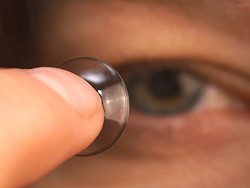
Doctors have analyzed the microflora of the conjunctiva (the transparent covering of the eye tissues) of individuals using contact lenses and those without them. Species diversity of bacteria in the first case approached the skin. Research scientists published in the journal of American Society for Microbiology.
Persons who use contact lenses, increases (in comparison with norm), the content of the conjunctiva of the bacteria Pseudomonas, Acinetobacter, and Methylobacterium, which is characteristic for the skin, and decreases the content of Haemophilus, Streptococcus, Staphylococcus and Corynebacterium, natural conjunctiva.
Scientists do not know the exact mechanism of the shift of the biodiversity of the conjunctiva occurring as a result of regular use of contact lenses. As a possible way to change the microflora in the South China sea is the transfer of bacteria from the skin of the fingers on the optical device, where the organisms fall on the conjunctiva. Also doctors do not exclude the operation of the selective pressure exerted by contact lenses on the conjunctiva in favor of natural skin bacteria.
The study involved 58 patients in whom we analyzed the microflora of the conjunctiva and of the skin under the eyes. From them 20 persons (of whom 9 use contact lenses) three times a day for six weeks were taken for the analyses of the microflora of the conjunctiva and of the skin under the eyes. Only at the disposal of scientists there were 250 samples microflorae.
In the world over a hundred million people use contact lenses, according to the office of sanitary inspection behind quality of foodstuff and medicines of the USA. About a third of them live in the United States. The use of optical devices to help correct vision, but is associated with an increased risk of developing eye diseases, particularly conjunctivitis and keratitis.








